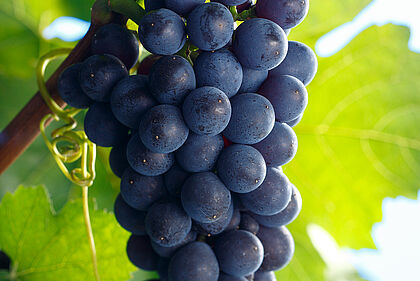Frühburgunder
Rote Rebsorten
Frühburgunder
One of the oldest cultivated vines in the Pinot family, producing intense, spicy and full-bodied wines.
Importance and cultivation
Frühburgunder is a natural mutation of Spätburgunder (Pinot Noir) and comes from the widely distributed Pinot family of Burgundy. The grape variety got its name from its early ripening in August - two weeks before the Pinot Noir grape. After the vine had almost died out in the 1960s due to low yields and disease infestation, it was re-established in the 1970s through targeted conservation measures by what is now known as Geisenheim Technical University.
Frühburgunder vines occupy 228 hectares of vineyards (2021) in Germany, mostly in the three winegrowing regions of Ahr (33 ha), Pfalz (50 ha) and Rheinhessen (77 ha). As a crop characteristic for the region, Frühburgunder from the Ahr was included in the "Ark of Taste" by the Slow Food association.
Enjoyment
Due to its strong notes, Frühburgunder is suitable as an accompaniment to game with heavy sauces or spicy cheeses. Frühburgunder is also an elegant companion to fish and asparagus dishes.

Vinification and taste
The red wine is often matured in wooden barrels or in barriques and can be stored for five years without any problems. Typical for Frühburgunder are dark ruby red and fruity aromas such as cherry, blackberry, blackcurrant and raspberry. Smoky notes are also often present. The delicate spiciness and mild acidity give Frühburgunder wines a particularly pleasant flavour. The wines of the Frühburgunder grape often appear more velvety and full-bodied than those from Spätburgunder. As a blending partner, Frühburgunder refines every wine as well as giving it an exceptionally strong, red colour.
